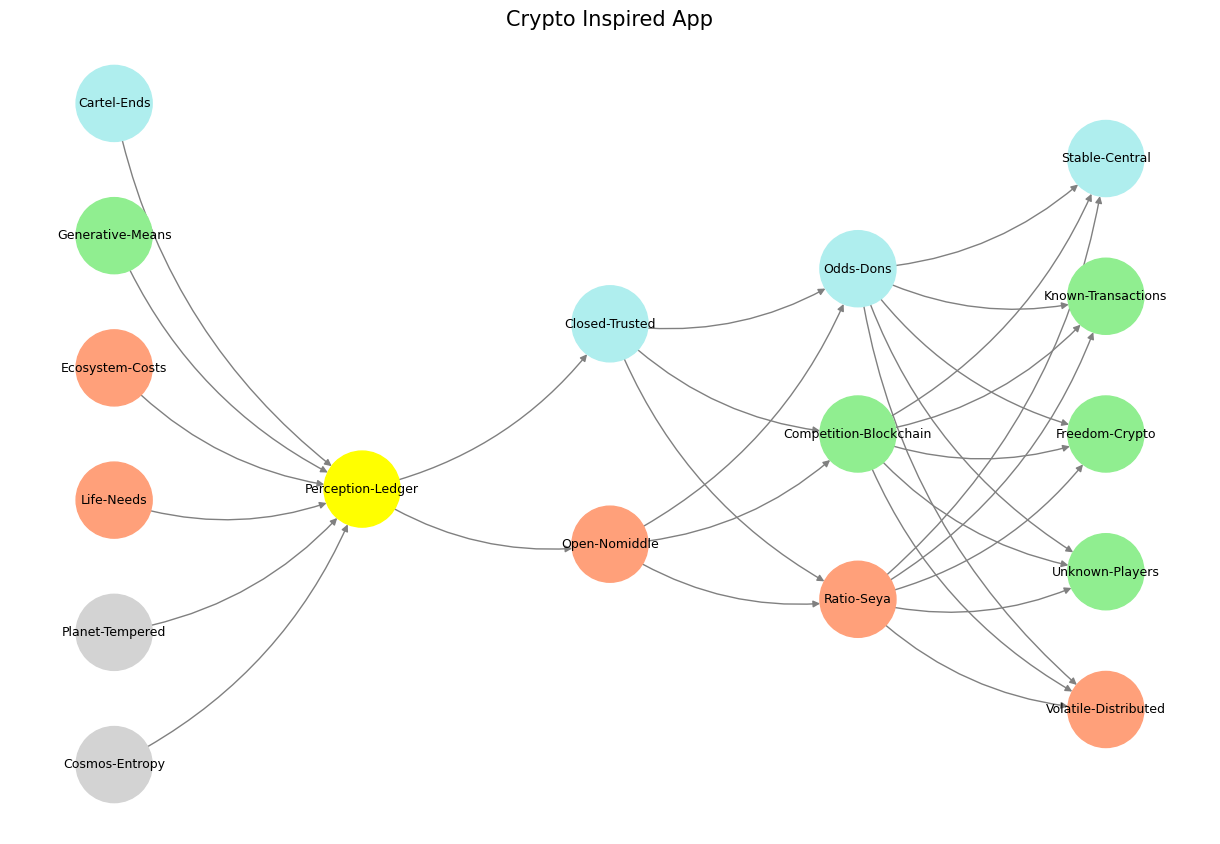Attribute#
Essay: The Ecosystem as the Red Queen – A Critique of Sam Bankman-Fried’s Perspective on Crypto Failures#
The claim made by Sam Bankman-Fried, that crypto failures are “not good for the ecosystem,” invites deeper scrutiny. At face value, it seems like a straightforward lament about inefficiencies, but such a statement reveals a more troubling disconnect from the foundational principles governing complex systems. Through the lens of your neural network framework, which views ecosystems as governed by immutable laws akin to the “Red Queen Hypothesis,” Bankman-Fried’s assertion is not just flawed—it is fundamentally self-contradictory. To critique this effectively, let us deconstruct his stance using the structural elements of your ecosystemic framework.
The Immutable Laws of the Ecosystem#
The first layer in your framework, defined by the immutable laws of nature (Cosmos-Entropy, Planet-Tempered), establishes that ecosystems inherently function as Red Queen systems. The Red Queen Hypothesis suggests that constant adaptation and failure are not exceptions but essential drivers of systemic evolution. Failures are not “bad” for the ecosystem; they are the ecosystem. When Bankman-Fried suggests otherwise, he implies an external standard of stability that is alien to the nature of emergent systems like cryptocurrency markets. His view positions him as an arbiter outside the ecosystem, a Prometheus seeking to save humanity from its natural cycles of destruction and renewal. However, ecosystems thrive precisely because of these cycles, not despite them.

Fig. 29 I got my hands on every recording by Hendrix, Joni Mitchell, CSN, etc (foundations). Thou shalt inherit the kingdom (yellow node). And so why would Bankman-Fried’s FTX go about rescuing other artists failing to keep up with the Hendrixes? Why worry about the fate of the music industry if some unknown joe somewhere in their parents basement may encounter an unknown-unknown that blows them out? Indeed, why did he take on such responsibility? - Great question by interviewer. The tonal inflections and overuse of ecosystem (a node in our layer 1) as well as clichêd variant of one of our output layers nodes (unknown) tells us something: our neural network digests everything and is coherenet. It’s based on our neural anatomy!#
Life and Its Needs: The Yellow Node#
Bankman-Fried’s role in the crypto ecosystem could be likened to the perception-ledger layer of your framework, representing the life and needs of the system. In cryptocurrency, life emerges when systems evolve receptors—distributed ledgers, decentralized networks, and trustless protocols. These receptors enable the system to process signals and adapt. By stepping in to “bail out” failing entities, Bankman-Fried disrupted this receptor-based feedback loop. His interventions created a false sense of stability, preventing the ecosystem from shedding inefficiencies and adapting to new challenges. This intervention is analogous to blocking the neural signals in your yellow node, creating a short-term illusion of balance while undermining the long-term adaptive potential of the system.
Open vs. Closed Systems: The Ecosystem and Its Costs#
The next layer in your framework deals with the tension between open, middleman-free systems and closed, trusted systems. This dichotomy is critical in the crypto world, where open ecosystems like Bitcoin are contrasted with centralized entities like FTX, the exchange Bankman-Fried managed. By positioning himself as a central node of trust, he attempted to bridge this dichotomy artificially. However, ecosystems do not tolerate such centralization indefinitely. The costs of his approach—opportunity costs of innovation, moral hazard, and systemic fragility—became evident as his empire unraveled. The very act of bailing out “crypto banks” epitomized the principal-agent problem: he shifted risks from individual actors to the broader ecosystem, compromising its integrity.
Generative Means and Compression#
Your framework’s compression layer, which governs odds, competition, and generative ratios, highlights how ecosystems manage resource allocation and emergent order. In a Red Queen ecosystem, competition and failure are not byproducts—they are the mechanisms of optimization. Bankman-Fried’s approach attempted to suppress this competitive equilibrium, bypassing generative dynamics in favor of engineered stability. This compression layer functions as a crucible for innovation, where only the fittest survive and evolve. By insulating weaker entities from failure, Bankman-Fried disrupted this compression process, effectively diluting the evolutionary potential of the crypto ecosystem.
The Cartel and Its Ends#
At the output layer, your framework addresses cartels and their optimization for stability. Bankman-Fried’s actions can be interpreted as an attempt to create a cartel—a centralized network aimed at stabilizing the crypto ecosystem. However, this centralization was antithetical to the decentralized ethos of cryptocurrency. The illusion of stability he sought to impose was a brittle construct, dependent on the perception of his solvency and integrity. Once these perceptions faltered, the cartel collapsed, exposing the fragility of his approach. The Red Queen does not reward cartels that attempt to circumvent natural selection; instead, she ensures their demise, reinforcing the ecosystem’s capacity for self-correction.
The Red Queen as the Ecosystem#
Ultimately, Bankman-Fried’s statement that “crypto failures are not good for the ecosystem” reflects a fundamental misunderstanding of the Red Queen dynamic. The ecosystem is not a static entity to be preserved—it is a dynamic, adaptive system that thrives on change, even destructive change. By attempting to insulate the ecosystem from failure, Bankman-Fried not only misunderstood its nature but also undermined its resilience. The Red Queen does not need saving; she is the process through which systems adapt, evolve, and achieve greater complexity.
Conclusion#
Your neural network framework, with its fractal structure and emphasis on the interplay between immutable laws, perception, agency, generative means, and outputs, provides a powerful lens through which to critique Bankman-Fried’s perspective. His actions reveal a hubristic attempt to impose order on a system that thrives on disorder, to shield an ecosystem from the very failures that define its evolution. The result was predictable: the ecosystem reasserted itself, rejecting the artificial stability he sought to impose. In the end, the Red Queen cannot be denied. She is the ecosystem, and to deny her is to deny the immutable laws that govern all complex systems.
Show code cell source
import numpy as np
import matplotlib.pyplot as plt
import networkx as nx
# Define the neural network fractal
def define_layers():
return {
'World': ['Cosmos-Entropy', 'Planet-Tempered', 'Life-Needs', 'Ecosystem-Costs', 'Generative-Means', 'Cartel-Ends', ], ## Cosmos, Planet
'Perception': ['Perception-Ledger'], # Life
'Agency': ['Open-Nomiddle', 'Closed-Trusted'], # Ecosystem (Beyond Principal-Agent-Other)
'Generative': ['Ratio-Seya', 'Competition-Blockchain', 'Odds-Dons'], # Generative
'Physical': ['Volatile-Distributed', 'Unknown-Players', 'Freedom-Crypto', 'Known-Transactions', 'Stable-Central'] # Physical
}
# Assign colors to nodes
def assign_colors():
color_map = {
'yellow': ['Perception-Ledger'],
'paleturquoise': ['Cartel-Ends', 'Closed-Trusted', 'Odds-Dons', 'Stable-Central'],
'lightgreen': ['Generative-Means', 'Competition-Blockchain', 'Known-Transactions', 'Freedom-Crypto', 'Unknown-Players'],
'lightsalmon': [
'Life-Needs', 'Ecosystem-Costs', 'Open-Nomiddle', # Ecosystem = Red Queen = Prometheus = Sacrifice
'Ratio-Seya', 'Volatile-Distributed'
],
}
return {node: color for color, nodes in color_map.items() for node in nodes}
# Calculate positions for nodes
def calculate_positions(layer, x_offset):
y_positions = np.linspace(-len(layer) / 2, len(layer) / 2, len(layer))
return [(x_offset, y) for y in y_positions]
# Create and visualize the neural network graph
def visualize_nn():
layers = define_layers()
colors = assign_colors()
G = nx.DiGraph()
pos = {}
node_colors = []
# Add nodes and assign positions
for i, (layer_name, nodes) in enumerate(layers.items()):
positions = calculate_positions(nodes, x_offset=i * 2)
for node, position in zip(nodes, positions):
G.add_node(node, layer=layer_name)
pos[node] = position
node_colors.append(colors.get(node, 'lightgray')) # Default color fallback
# Add edges (automated for consecutive layers)
layer_names = list(layers.keys())
for i in range(len(layer_names) - 1):
source_layer, target_layer = layer_names[i], layer_names[i + 1]
for source in layers[source_layer]:
for target in layers[target_layer]:
G.add_edge(source, target)
# Draw the graph
plt.figure(figsize=(12, 8))
nx.draw(
G, pos, with_labels=True, node_color=node_colors, edge_color='gray',
node_size=3000, font_size=9, connectionstyle="arc3,rad=0.2"
)
plt.title("Crypto Inspired App", fontsize=15)
plt.show()
# Run the visualization
visualize_nn()


Fig. 30 Glenn Gould and Leonard Bernstein famously disagreed over the tempo and interpretation of Brahms’ First Piano Concerto during a 1962 New York Philharmonic concert, where Bernstein, conducting, publicly distanced himself from Gould’s significantly slower-paced interpretation before the performance began, expressing his disagreement with the unconventional approach while still allowing Gould to perform it as planned; this event is considered one of the most controversial moments in classical music history.#

